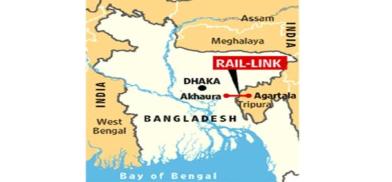Involve Japan in enhancing India-Bangladesh connectivity, unlocking potential of India’s Northeast
Apart from engaging in projects for upgrading India highways that go all the way till the Bangladesh border, Japan could also collaborate with India in the constantly deferred Agartala (India)-Akhaura (Bangladesh) rail link, something that provides scope for Indo-Japan collaboration under India’s Act East Policy and Japan’s Free and Open Indo-Pacific Strategy, writes Prarthana Sen for South Asia Monitor

India’s northeastern region provides the only land link between India and Myanmar, China, Bangladesh and Bhutan. India is trying to develop connectivity in the region as its gateway to Southeast Asia. However, the progression of proposed rail projects between India and her immediate neighbours has been rather slow.
India’s Northeast is yet to have any form of rail connectivity with Nepal, Myanmar and Bhutan despite geographic proximity. The upcoming Agartala-Akhaura rail link enables the region to overcome its geographical handicap as a landlocked region and strengthens Bangladesh’s emergence as a regional transit hub. This is because the Akhaura railway junction connects with Chittagong seaport -- enabling landlocked Tripura (Agartala) access to the Bay of Bengal.
Since building regional networks via road and rail linkages to connect its landlocked northeast with Southeast Asia forms an integral part of India’s Act East policy, the Agartala (India)-Akhaura (Bangladesh) rail project will serve similar interests. Bangladesh’s geostrategic location situates it between South Asia and Southeast Asia. Bangladesh could thus, bridge India’s landlocked northeast with Southeast Asia via such connectivity initiatives. Despite delays, it is imperative that the Agartala-Akhaura rail link commences operations soon, serving as a starting point for rail connectivity between India’s neighbours and the Indian northeast.
Endless delays
The railway tracks were to be laid by 2017 as per the original deadline. However, several factors contributed to delays- and the project cost is now estimated to cost more for both countries.
The deadline got extended after the Covid-19 pandemic stalled construction work on both sides of the border. While work on the Indian side is nearing completion, much work remains to be done in Bangladesh. The Agartala-Akhaura link is likely to be completed by September-end in 2022, if not fettered by further delays.
In addition, the project has faced obstacles in the form of land acquisition-related and alignment issues over the rail line in Bangladesh. There have been efforts by both sides to resolve these issues by sending a group of experts constituting representatives of the Bangladesh government, the Indian High Commission in Dhaka and the Indian Railway Construction Ltd (IRCON) to sites where the tracks are being laid to carry out assessments.
Legal tiff
A third contributing factor to the project’s delay was marked by a legal battle between India-based firm Texmaco Rail and Engineering (TEXMACO) and Bangladesh Railway. TEXMACO had been roped in to oversee the construction of the link in 2018, with the project scheduled for completion within 18 months. TEXMACO claimed that delays in work pace was due to the pandemic, limited resources in Bangladesh and non-payment of its dues for a long time.
Firstly, the railway link connects Bangladesh with Nischintapur, which has India’s first transhipment yard in the northeast. It shall not only add momentum for Indo-Bangladesh trade but also be used for checking documents of passengers travelling to and from Bangladesh.
Secondly, the Agartala-Akhaura link shall boost connectivity within India. The Siliguri corridor is the only land link that connects the northeast to the Indian mainland. With the opening up of the rail link, trains carrying goods from different parts of the country can reach the northeast via Bangladesh faster and with lesser transportation cost.
Thirdly, the Agartala-Akhaura link shall boost connectivity within Bangladesh. Since it is expected to serve as a part of the Trans-Asian Railway Network (TARN), the project shall fully connect the eastern and western parts of Bangladesh, in addition to fostering trade ties and a people-to-people connect with India.
Involve Japan
Finally, the initiative reinvigorates historical ties between the friendly neighbours that share a common heritage and cultural values. During the colonial days, Akhaura served as the rail head for Agartala prior to partition.
Bangladesh Railway Minister Nurul Islam has expressed great discontent over the slow progress in the rail link’s construction. He has asked the contractor to speed up efforts to finish the project by year-end. If not, a new firm shall have to be assigned if the delay persists. This is where Japan’s involvement could be crucial.
In its quest for ensuring a free and open Indo-Pacific, Japan has embarked in various collaborations with India to enhance connectivity in Bangladesh and the India’s Northeast. Apart from engaging in projects for upgrading India highways that go all the way till the Bangladesh border, Japan could also collaborate with India in the constantly deferred Agartala (India)-Akhaura (Bangladesh) rail link, something that provides scope for Indo-Japan collaboration under India’s Act East Policy and Japan’s Free and Open Indo-Pacific Strategy.
Japan has been involved in the construction of a Multimodal Transport Hub at Bangladesh’s Biman Bandar and Kamalapur railway stations and developing the Dhaka Metro Rail. Since Japanese companies are greatly interested in Bangladesh as an investment destination, its involvement in the strategically important Agartala-Akhaura link will be a win-win situation.
(The writer is a Master’s graduate in Political Science from St. Xavier’s College, Kolkata and former Research Assistant at ORF. Views are personal. She can be contacted at sen.prarthana19@gmail.com.)










Post a Comment